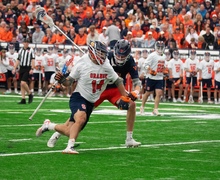Crunching the numbers of Malachi Richardson’s impressive responses to low-scoring 1st halves
Logan Reidmsa | Staff Photographer
Malachi Richardson has scored three or fewer points in the first half 11 times. Eight of those, he's scored 10-plus points in the second half.
Malachi Richardson’s last touch of the first half resulted in him lying on his back under Syracuse’s basket. Twenty-five seconds remained and Georgia Tech pushed the other way. An attempt to split two defenders and maneuver into the lane turned into a stumble, fall and forgettable end to the freshman’s scoreless opening frame.
After the game, when Richardson had 13 points to his name after guiding Syracuse to a narrow win, Jim Boeheim wasn’t surprised. It’s happened before, three or four times the head coach estimated, when Richardson has wiped a rocky first-half slate clean with a breakout latter 20 minutes.
Eleven times this season the freshman has scored three or fewer points in the first half. Eight of those games, Richardson has rebounded with double-digit scoring outputs in the second frame. In seven of those eight, Syracuse has won. Richardson may not be the consistent point producer that Michael Gbinije is (he’s only scored three or fewer points in the first half once), but the freshman has proven to bounce back from low-scoring starts better than every other teammate who falls under this criteria:
-Score three or fewer points in the first half, which will be considered a “low-scoring start” for all intents and purposes
–Have a “low-scoring start” in at least a fifth of Syracuse’s games
–Play a minimum of 16 minutes per contest
In turn, Richardson has given the Orange a reliable scoring outlet down the stretch of games even when he’s anything but early on. It’s part of the identity he’s developed as a natural scorer, with little alternative to emerge from an in-game slump other than to keep attacking.
“He’s going to keep shooting and playing,” Boeheim said. “That’s what he’s going to do.”
For perspective on how Richardson sizes up to his teammates in responding to “low-scoring first halves,” here’s a look at each Syracuse player who fits the criteria mentioned above (excluding Gbinije due to low sample size).

The only game SU didn’t win when Richardson followed the trend was against St. John’s, when his 15 points, in his mind, were nowhere near enough to compensate for a 4-of-20 shooting day from the field. Isolated in a corner of Syracuse’s locker room at Madison Square Garden, Richardson spoke softly and said it was the first game he’d ever shot that badly from 3 – a paltry 0-of-11 mark with five misses in the first and six in the second.
Despite an abysmal shooting performance, he was still able to get to the foul line for eight attempts in the second half. And in the eight games he’s responded with double digits after “low-scoring first halves,” Richardson has taken a combined 44 second-half free throws, which equates to almost three trips to the line in the second half of each game.
“That’s what he’s been more focused on,” his close friend Rob Hines said. “When he’s not shooting the ball well in the first half, coming in the second half and just getting in the paint and just making plays that way.”
In Syracuse’s win over Texas A&M that bumped the Orange to 6-0 and No. 14 in the country, Richardson went 1-of-5 from the field with a lone 3 to account for a trio of first-half points.
In the second frame, he scored 13, getting to the foul line four times and making all six foul shots.
“It’s two halves,” Richardson said after the game. “It’s always more.”
For Syracuse, the second chunk of conference play has helped resuscitate a team. For Richardson, the second half of games has often helped resuscitate a player.
After the win against Georgia Tech, Boeheim was asked if it’s not maturity, how is Richardson able to adjust after flat first halves. He cut off the question, with an answer as cut and dry as the reason behind it.
“He’s done it all year,” Boeheim said. “He’s a scorer. He’s not going to lose his confidence.”
Published on February 1, 2016 at 11:22 pm
Contact Matt: [email protected] | @matt_schneidman




